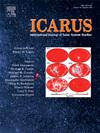Multi-instrument sounding of a Jovian thunderstorm from Juno
IF 2.5
2区 物理与天体物理
Q2 ASTRONOMY & ASTROPHYSICS
引用次数: 0
Abstract
Thunderstorms play a significant role in transporting heat from the deep interior to space on giant planets. We present observations of a 3,400-km wide thunderstorm complex in Jupiter’s North Equatorial Belt (NEB) during the 38th periapse of the Juno spacecraft on 29 Nov. 2021. Data were acquired by the Microwave Radiometer (MWR), the visible light JunoCam instrument, the Jovian InfraRed Auroral Mapper (JIRAM), and from supporting Earth-based imaging. This was the first time Juno was able to observe a thunderstorm at suitably low emission angles with multiple instruments at close range (5,690 km), making it the most comprehensive close-up assessment of a Jovian thunderstorm to date. Lightning detection confirmed the Storm’s vigorous convective nature. MWR brightness temperatures indicate this Storm appears to be wholly contained within the weather layer, i.e., no deeper than the expected base of the HO cloud, and not as a result of any detected deep-seated upwelling beneath the HO cloud base. Earth-based observations tracked it over its 2-week lifespan, providing evidence that mesoscale-to-synoptic-scale forcing mechanisms were involved in sustaining it, including the intriguing possibility of a humidity front (‘dryline’), a sharp gradient in the vapor abundance, promoting lift along a concentrated region.

朱诺号多仪器探测木星雷暴
在巨行星上,雷暴在将热量从内部深处输送到太空中起着重要作用。我们在2021年11月29日朱诺号航天器第38次近日点期间,在木星北赤道带(NEB)观测到一个3400公里宽的雷暴复群。数据由微波辐射计(MWR)、可见光朱诺卡姆(JunoCam)仪器、木星红外极光成像仪(JIRAM)以及支持地球成像的仪器获取。这是朱诺号第一次在近距离(约5690公里)用多种仪器在合适的低发射角度观测到雷暴,使其成为迄今为止对木星雷暴最全面的近距离评估。闪电探测证实了风暴的强烈对流性质。MWR亮度温度表明,这场风暴似乎完全包含在天气层内,即不超过H2O云的预期底部,而不是由于在H2O云底部探测到任何深层上升流。基于地球的观测跟踪了它约2周的寿命,提供了中尺度到天气尺度强迫机制参与维持它的证据,包括湿度锋(“干线”)的有趣可能性,蒸汽丰度的急剧梯度,促进了沿集中区域的抬升。
本文章由计算机程序翻译,如有差异,请以英文原文为准。
求助全文
约1分钟内获得全文
求助全文
来源期刊

Icarus
地学天文-天文与天体物理
CiteScore
6.30
自引率
18.80%
发文量
356
审稿时长
2-4 weeks
期刊介绍:
Icarus is devoted to the publication of original contributions in the field of Solar System studies. Manuscripts reporting the results of new research - observational, experimental, or theoretical - concerning the astronomy, geology, meteorology, physics, chemistry, biology, and other scientific aspects of our Solar System or extrasolar systems are welcome. The journal generally does not publish papers devoted exclusively to the Sun, the Earth, celestial mechanics, meteoritics, or astrophysics. Icarus does not publish papers that provide "improved" versions of Bode''s law, or other numerical relations, without a sound physical basis. Icarus does not publish meeting announcements or general notices. Reviews, historical papers, and manuscripts describing spacecraft instrumentation may be considered, but only with prior approval of the editor. An entire issue of the journal is occasionally devoted to a single subject, usually arising from a conference on the same topic. The language of publication is English. American or British usage is accepted, but not a mixture of these.
 求助内容:
求助内容: 应助结果提醒方式:
应助结果提醒方式:


